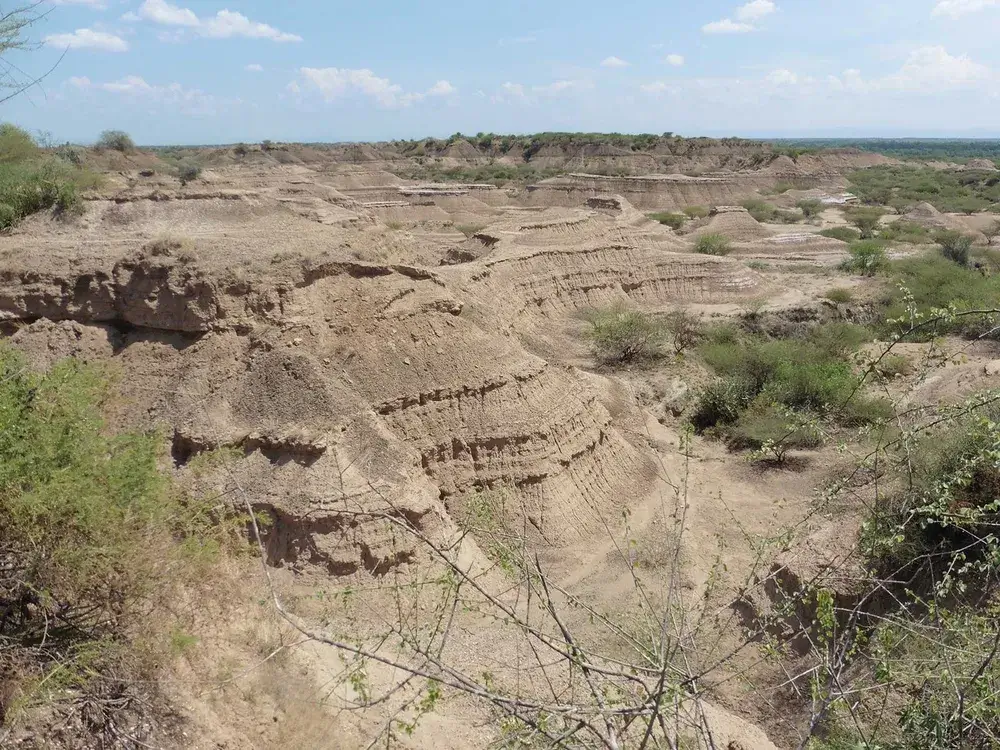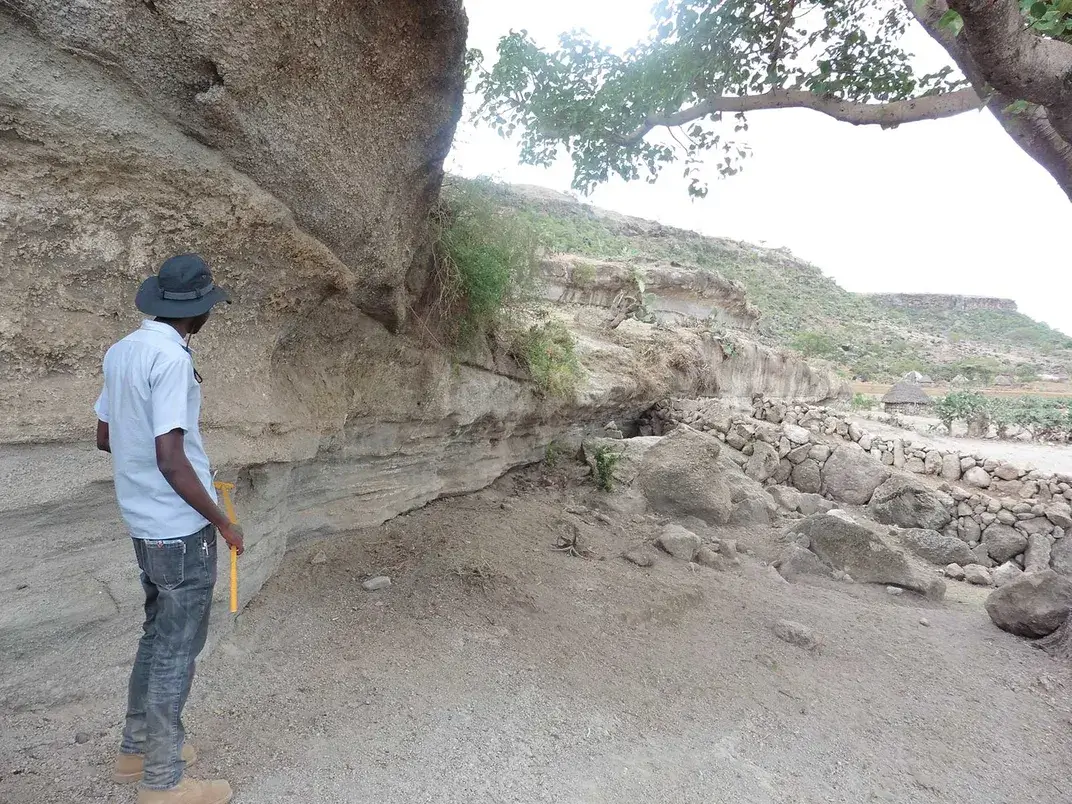
East Africa’s Oldest Modern Human Fossil Is Way Older Than Previously Thought
Analysis of ash from a massive volcanic eruption places the famed Omo I fossil 36,000 years back in time.
By: Brian Handwerk | Smithsonian
At a remote region in south-western Ethiopia, the Omo River and its long-vanished tributaries have laid bare rugged bluffs and hillsides, exposing a layer cake of ancient sediments and the trapped remains of early humans. Before the COVID-19 pandemic, Céline Vidal and colleagues journeyed to this site known as the Kibish Formation to work in scorching temperatures up to 110 degrees Fahrenheit, picking through the ashes of ancient volcanic eruptions to learn more about some of the oldest members of our species.
“It was an adventure,” says Vidal, a volcanologist at the University of Cambridge, who studies how ancient eruptions impacted climate and civilizations. “This is the part of science that online life isn’t ever going to replace.”
One of the reasons Vidal and colleagues came to the site was to learn about Omo I, one of the oldest known examples of Homo sapiens. Using geochemical clues to match the layer of volcanic ash blanketing the fossil to a specific volcanic eruption, they discovered Omo I is 36,000 years older than previously believed. Ash from an enormous eruption of the Ethiopian Rift’s Shala volcano was put down atop the sediment layer containing the Omo I fossil approximately 233,000 years ago, which means that Omo I and her kind lived here at least that long ago.
“Each eruption has a unique geochemical composition, a kind of fingerprint which we can use to try to figure out exactly which eruption on the Ethiopian Rift would have created a layer of volcanic ash,” Vidal explains. “We found a match for the ash layer that covers the fossils, so we know which eruption produced that ash and the age of that eruption.”
The findings, published this week in the journal Nature, show that Omo I had to be older than the layer that later fell from the sky to rest atop her remains, but they don’t reveal her maximum age. It may later be possible to determine the oldest possible date for Omo I if the team can similarly identify another volcanic layer from below the fossil.

Famed paleoanthropologist Richard Leakey and colleagues found Omo I near the southern Ethiopian town of Kibish in 1967. Originally, scientists dated freshwater mollusk shells found with the skull to conclude that that the remains were about 130,000 years old. They also saw from the beginning, quite clearly, that the skull’s flat face, prominent chin and high forehead were distinctly modern, and that this ancient person should be classified as a member of our own species.
For more than half a century the fossil has been known as one of the oldest existing Homo sapiens skulls anywhere in the world. (The partial skull and skeleton were considered the oldest until the 2017 discovery of 300,000-year-old skull, jaw and tooth fragments from Jebel Irhoud, Morocco.) In 2005, radioactive dating study pushed back the age of the fossil skull significantly, to 195,000 years ago. But today’s study now suggests that Omo I is actually tens of thousands of years older.

The era in which Homo sapiens likely first appeared and gradually evolved in Africa, between about 360,000 years ago and 100,000 years ago, was one of cataclysmic volcanic activity. Enormous eruptions rocked the region, depositing thick layers of ash that would have made some localities uninhabitable. Because changing environments sometimes pushed early humans to adopt new behaviours and tools, these eruptions might have actually played a part in shaping evolution here. Perhaps they caused groups of ancient humans to move around, encountering one another and exchanging everything from genes to technologies before separating again.
More certainly, the volcanic ash helped to create a record of what occurred during the turbulent era.
At the Kibish formation, researchers were stumped by a massive layer of ash, more than six feet thick, just above the sediments where Omo I and other fossils were found. At a distance of nearly 200 miles away from the nearest ancient volcano, the ash was flour-like, so fine that it lacked enough large crystals to be used for radiometric dating, which provides an age by measuring how much of the mineral’s radioactive potassium has decayed into radioactive argon. “This material just wasn’t suitable for the type of techniques we normally use,” Vidal explains.
But Vidal and colleagues were able to determine the age of the eruption that deposited the ash by sampling rocks closer to their volcanic sources, in places where ashy debris contained plenty of larger crystals suitable for radiometric dating.
“It’s really neat work to be able to go to the volcanic complexes, and collect samples right from the source, and connect them chemically in a very precise way to what was found at the fossil site itself,” says Rick Potts, director of the Smithsonian’s Human Origins Program, who wasn’t involved with the study.
Dates for important fossils like Omo I are extremely important for scientists who are piecing together an evolutionary timeline of Homo sapiens. They provide a solid framework to help track changes in evolution, like human appearance, or in behaviour, like tool technologies. They also lend context to events like dramatic climate shifts that may have helped to drive those adaptations. “In any given region, it’s useful to establish the earliest appearance of something that looks very, very much like a H. Sapiens skull,” says Potts. “And that’s Omo I.”
Omo I’s fascinating skull shape shows that humans living in eastern Africa 230,000 years ago had already evolved to the point that they looked much like ourselves. But that’s not the whole story. Leakey’s team found a second set of remains at the site, dubbed Omo II, which appears to be the same age but has a quite different and more archaic look that has sparked debate on whether it’s truly a Homo sapiens.
From about 350,000 to 160,000 years ago the human fossil record shows a mixing and matching of different traits, in different times and places, some of which are more primitive and others more modern. This paradigm makes the remains of Omo I and Omo II particularly interesting, Potts notes, because such variation can be seen side by side.
“Whether it may be the same gene pool, or two neighbouring groups of hominins, this basis for the combining of archaic and modern looking traits is sort of encapsulated by what happened to be two fossil individuals collated at Kibish by Richard Leakey in the 1960s,” Potts says. “As is true for many animals, the origin of our own species wasn’t an event but a more gradual process that took place over time.”
* * *
NEXT UP!
Drought Reveals 113-Million-Year-Old Dinosaur Tracks In Texas
Drought has dried up part of a river in central Texas, revealing 113-million-year-old dinosaur tracks.
The prehistoric footprints emerged at Dinosaur Valley State Park, which is located in the town of Glen Rose, southwest of the Dallas-Fort Worth area.
As the name suggests, the park already protects other dinosaur footprints. But the tracks that recently emerged are usually hidden under the mud, silt and waters of the Paluxy River. This summer, however, water levels have dipped so low that the prehistoric indentations are now visible. So far, volunteers have counted 75 newly exposed footprints in the parched riverbed.
* * *
READ MORE: This Ancient Maya City Was Hidden In The Jungle For More Than 1,000 Years
Fascinating! Guanches: Ancient Mummies of The Canary Islands (Video)
Telegram: Stay connected and get the latest updates by following us on Telegram!
We’d love to hear from you! If you have a comment about this article or if you have a tip for a future Collective Spark Story please let us know below in the comment section.
